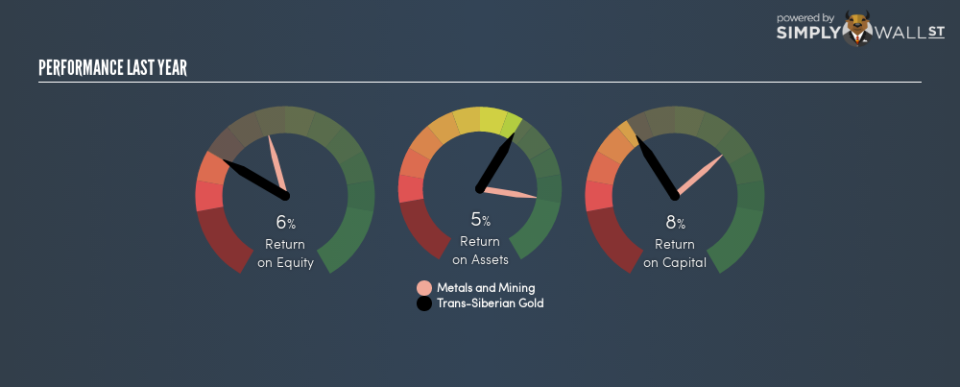Is Trans-Siberian Gold plc (LON:TSG) Investing Your Capital Efficiently?

Want to participate in a short research study? Help shape the future of investing tools and you could win a $250 gift card!
Today we’ll evaluate Trans-Siberian Gold plc (LON:TSG) to determine whether it could have potential as an investment idea. In particular, we’ll consider its Return On Capital Employed (ROCE), as that can give us insight into how profitably the company is able to employ capital in its business.
First up, we’ll look at what ROCE is and how we calculate it. Next, we’ll compare it to others in its industry. Then we’ll determine how its current liabilities are affecting its ROCE.
Return On Capital Employed (ROCE): What is it?
ROCE is a measure of a company’s yearly pre-tax profit (its return), relative to the capital employed in the business. All else being equal, a better business will have a higher ROCE. Overall, it is a valuable metric that has its flaws. Renowned investment researcher Michael Mauboussin has suggested that a high ROCE can indicate that ‘one dollar invested in the company generates value of more than one dollar’.
How Do You Calculate Return On Capital Employed?
Analysts use this formula to calculate return on capital employed:
Return on Capital Employed = Earnings Before Interest and Tax (EBIT) ÷ (Total Assets – Current Liabilities)
Or for Trans-Siberian Gold:
0.081 = US$5.9m ÷ (US$109m – US$11m) (Based on the trailing twelve months to June 2018.)
Therefore, Trans-Siberian Gold has an ROCE of 8.1%.
View our latest analysis for Trans-Siberian Gold
Is Trans-Siberian Gold’s ROCE Good?
One way to assess ROCE is to compare similar companies. In this analysis, Trans-Siberian Gold’s ROCE appears meaningfully below the 13% average reported by the Metals and Mining industry. This performance could be negative if sustained, as it suggests the business may underperform its industry. Setting aside the industry comparison for now, Trans-Siberian Gold’s ROCE is mediocre in absolute terms, considering the risk of investing in stocks versus the safety of a bank account. Investors may wish to consider higher-performing investments.
Trans-Siberian Gold’s current ROCE of 8.1% is lower than its ROCE in the past, which was 18%, 3 years ago. Therefore we wonder if the company is facing new headwinds.
It is important to remember that ROCE shows past performance, and is not necessarily predictive. ROCE can be deceptive for cyclical businesses, as returns can look incredible in boom times, and terribly low in downturns. ROCE is only a point-in-time measure. Remember that most companies like Trans-Siberian Gold are cyclical businesses. If Trans-Siberian Gold is cyclical, it could make sense to check out this free graph of past earnings, revenue and cash flow.
What Are Current Liabilities, And How Do They Affect Trans-Siberian Gold’s ROCE?
Current liabilities are short term bills and invoices that need to be paid in 12 months or less. Due to the way ROCE is calculated, a high level of current liabilities makes a company look as though it has less capital employed, and thus can (sometimes unfairly) boost the ROCE. To check the impact of this, we calculate if a company has high current liabilities relative to its total assets.
Trans-Siberian Gold has total liabilities of US$11m and total assets of US$109m. As a result, its current liabilities are equal to approximately 9.8% of its total assets. Trans-Siberian Gold reports few current liabilities, which have a negligible impact on its unremarkable ROCE.
What We Can Learn From Trans-Siberian Gold’s ROCE
Trans-Siberian Gold looks like an ok business, but on this analysis it is not at the top of our buy list. But note: Trans-Siberian Gold may not be the best stock to buy. So take a peek at this free list of interesting companies with strong recent earnings growth (and a P/E ratio below 20).
For those who like to find winning investments this free list of growing companies with recent insider purchasing, could be just the ticket.
To help readers see past the short term volatility of the financial market, we aim to bring you a long-term focused research analysis purely driven by fundamental data. Note that our analysis does not factor in the latest price-sensitive company announcements.
The author is an independent contributor and at the time of publication had no position in the stocks mentioned. For errors that warrant correction please contact the editor at editorial-team@simplywallst.com.

 Yahoo Finance
Yahoo Finance 